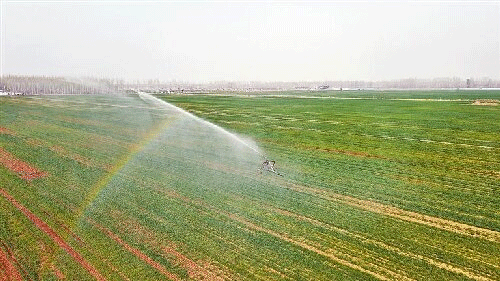Spring Irrigation in Yongqing: A New Era of Smart Farming for Wheat Production
Spring is a critical window for wheat cultivation, especially as crops transition from dormancy to vigorous vegetative growth. In Yongqing County, Hebei Province, 58,000 mu (approximately 3,867 hectares) of winter wheat is entering the greening stage, prompting an urgent call to complete spring irrigation—an essential first drink of water to fuel early growth and maximize yield potential.
By early April 2025, 49,000 mu of winter wheat had already been irrigated, with full coverage expected by the first week of April, according to local agricultural authorities.
Advanced Irrigation Technologies Transforming the Field
Grain grower Li Huan in Lilan Town is leading the charge with over 5,000 mu of wheat fields equipped with 20 self-propelled sprinkler systems. Each machine can irrigate up to 20 mu per day, and will operate continuously for 1.5 months to ensure full water and nutrient coverage.
These systems:
- Deliver uniform mist irrigation, minimizing water loss
- Allow integration of organic liquid fertilizers
- Promote deep root development
- Reduce the risk of pests and diseases
- Improve water use efficiency by 3 times compared to traditional flood irrigation
On the other side of the county in Liujiachang Village, Sanshengkou Township, wheat farmer Deng Shujuan has adopted shallow-buried drip irrigation, enabling water and fertilizer to be delivered directly to the root zone.
With 200 mu of wheat, she uses fertigation lines to save both water and labor. Her target: to complete spring irrigation within 10 days, maximizing early season root growth while conserving resources.
Why Spring Irrigation Matters
According to the China Meteorological Administration, northern China often experiences low soil moisture in early spring, especially after dry winters. Timely and precise spring irrigation helps:
- Break dormancy in wheat
- Stimulate tillering and uniform growth
- Reduce crop stress from moisture fluctuations
- Enhance nitrogen uptake and tiller survival
Recent field studies from the Chinese Academy of Agricultural Sciences (CAAS) show that precision irrigation combined with fertigation can increase wheat yields by 8–15%, while reducing water use by 30–40%.
Spring irrigation in Yongqing is no longer just a routine agricultural task—it’s a technologically driven operation shaping the future of sustainable wheat production. Through innovations like self-propelled sprinklers and drip fertigation systems, local farmers are not only conserving water but also boosting yields and reducing input costs. These practices offer a model for other regions facing similar climate and resource challenges.
Error





